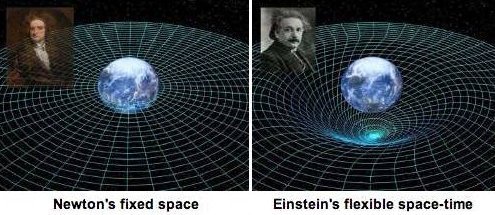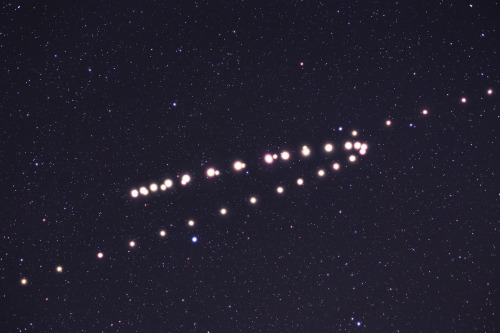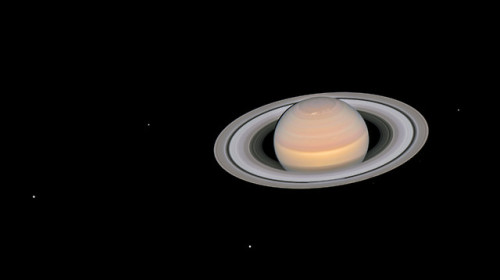What Are Gravitational Waves?
What are Gravitational Waves?
Today, the National Science Foundation (NSF) announced the detection of gravitational waves by the Laser Interferometer Gravitational-Wave Observatory (LIGO), a pair of ground-based observatories. But…what are gravitational waves? Let us explain:

Gravitational waves are disturbances in space-time, the very fabric of the universe, that travel at the speed of light. The waves are emitted by any mass that is changing speed or direction. The simplest example is a binary system, where a pair of stars or compact objects (like black holes) orbit their common center of mass.

We can think of gravitational effects as curvatures in space-time. Earth’s gravity is constant and produces a static curve in space-time. A gravitational wave is a curvature that moves through space-time much like a water wave moves across the surface of a lake. It is generated only when masses are speeding up, slowing down or changing direction.
Did you know Earth also gives off gravitational waves? Earth orbits the sun, which means its direction is always changing, so it does generate gravitational waves, although extremely weak and faint.
What do we learn from these waves?
Observing gravitational waves would be a huge step forward in our understanding of the evolution of the universe, and how large-scale structures, like galaxies and galaxy clusters, are formed.
Gravitational waves can travel across the universe without being impeded by intervening dust and gas. These waves could also provide information about massive objects, such as black holes, that do not themselves emit light and would be undetectable with traditional telescopes.

Just as we need both ground-based and space-based optical telescopes, we need both kinds of gravitational wave observatories to study different wavelengths. Each type compliments the other.
Ground-based: For optical telescopes, Earth’s atmosphere prevents some wavelengths from reaching the ground and distorts the light that does.
Space-based: Telescopes in space have a clear, steady view. That said, telescopes on the ground can be much larger than anything ever launched into space, so they can capture more light from faint objects.
How does this relate to Einstein’s theory of relativity?
The direct detection of gravitational waves is the last major prediction of Einstein’s theory to be proven. Direct detection of these waves will allow scientists to test specific predictions of the theory under conditions that have not been observed to date, such as in very strong gravitational fields.

In everyday language, “theory” means something different than it does to scientists. For scientists, the word refers to a system of ideas that explains observations and experimental results through independent general principles. Isaac Newton’s theory of gravity has limitations we can measure by, say, long-term observations of the motion of the planet Mercury. Einstein’s relativity theory explains these and other measurements. We recognize that Newton’s theory is incomplete when we make sufficiently sensitive measurements. This is likely also true for relativity, and gravitational waves may help us understand where it becomes incomplete.
Make sure to follow us on Tumblr for your regular dose of space: http://nasa.tumblr.com
More Posts from Riekod and Others

the InSight landing was so exciting!
~ november 26, 2018
The Unreasonable Effectiveness of Mathematics in the Natural Sciences
Scholars have often expressed astonishment for how well mathematics works to describe our physical world. In 1960, Eugene Wigner published an article with the title above commenting that
…the mathematical formulation of the physicist’s often crude experience leads, in an uncanny number of cases, to an amazingly accurate description of a large class of phenomena.
Here are some others’ thoughts:
The most incomprehensible thing about the universe is that it is comprehensible.
— Albert Einstein
Physics is mathematical not because we know so much about the physical world, but because we know so little; it is only its mathematical properties that we can discover.
— Bertrand Russell
How can it be that mathematics, being after all a product of human thought which is independent of experience, is so admirably appropriate to the objects of reality?
— Albert Einstein
Our physical world doesn’t have just some mathematical properties, it has only mathematical properties.
— Max Tegmark
Physicists may have fallen prey to a false dichotomy between mathematics and physics. It’s common for theoretical physicists to speak of mathematics providing a quantitative language for describing physical reality… But maybe… math is more than just a description of reality. Maybe math is reality.
— Brian Greene
More info at https://en.wikipedia.org/wiki/The_Unreasonable_Effectiveness_of_Mathematics_in_the_Natural_Sciences

Retrograde motion of Mars in the night sky of the Earth.
Image Credit: Tunc Tezel
This is how far into the earth humans have dug so far.


The 2MASS Redshift Survey - The single most comprehensive survey of the universe… and everything that’s in it.


Saturn and its moons at opposition (The visible moons are (from left to right) Dione, Enceladus, Tethys, Janus, Epimetheus and Mimas
Credit: NASA, ESA, A. Simon (GSFC) and the OPAL Team, and J. DePasquale (STScI)
How Big is Our Galaxy, the Milky Way?
When we talk about the enormity of the cosmos, it’s easy to toss out big numbers – but far harder to wrap our minds around just how large, how far and how numerous celestial bodies like exoplanets – planets beyond our solar system – really are.
So. How big is our Milky Way Galaxy?
We use light-time to measure the vast distances of space.
It’s the distance that light travels in a specific period of time. Also: LIGHT IS FAST, nothing travels faster than light.

How far can light travel in one second? 186,000 miles. It might look even faster in metric: 300,000 kilometers in one second. See? FAST.

How far can light travel in one minute? 11,160,000 miles. We’re moving now! Light could go around the Earth a bit more than 448 times in one minute.

Speaking of Earth, how long does it take light from the Sun to reach our planet? 8.3 minutes. (It takes 43.2 minutes for sunlight to reach Jupiter, about 484 million miles away.) Light is fast, but the distances are VAST.

In an hour, light can travel 671 million miles. We’re still light-years from the nearest exoplanet, by the way. Proxima Centauri b is 4.2 light-years away. So… how far is a light-year? 5.8 TRILLION MILES.

A trip at light speed to the very edge of our solar system – the farthest reaches of the Oort Cloud, a collection of dormant comets way, WAY out there – would take about 1.87 years.
Our galaxy contains 100 to 400 billion stars and is about 100,000 light-years across!
One of the most distant exoplanets known to us in the Milky Way is Kepler-443b. Traveling at light speed, it would take 3,000 years to get there. Or 28 billion years, going 60 mph. So, you know, far.
SPACE IS BIG.

Read more here: go.nasa.gov/2FTyhgH
Make sure to follow us on Tumblr for your regular dose of space: http://nasa.tumblr.com.
Thoughts and explanation about time travelling through a black hole?
A black hole curves the space-time fabric to an extreme point called singularity. And since space and time are working together, according to the theory of relativity, curvature and gravity also affect time.
This is best illustrated by one person (call them Unlucky) falling into a black hole while another person (call them Lucky) watches. From Lucky’s perspective, Unlucky’s time clock appears to be ticking slower and slower. This is in accordance with Einstein’s theory of general relativity, which (simply put) says that time is affected by how fast you go, when you’re at extreme speeds close to light. The black hole warps time and space so much that Unlucky’s time appears to be running slower. From Unlucky’s perspective, however, their clock is running normally and Lucky’s is running fast.

If you dropped a water balloon on a bed of nails, you’d expect it to burst spectacularly. And you’d be right – some of the time. Under the right conditions, though, you’d see what a high-speed camera caught in the animation above: a pancake-shaped bounce with nary a leak. Physically, this is a scaled-up version of what happens to a water droplet when it hits a superhydrophobic surface.
Water repellent superhydrophobic surfaces are covered in microscale roughness, much like a bed of tiny nails. When the balloon (or droplet) hits, it deforms into the gaps between posts. In the case of the water balloon, its rubbery exterior pulls back against that deformation. (For the droplet, the same effect is provided by surface tension.) That tension pulls the deformed parts of the balloon back up, causing the whole balloon to rebound off the nails in a pancake-like shape. For more, check out this video on the student balloon project or the original water droplet research. (Image credits: T. Hecksher et al., Y. Liu et al.; via The New York Times; submitted by Justin B.)

-
 empress-rara liked this · 3 months ago
empress-rara liked this · 3 months ago -
 fandomhopper8 liked this · 3 months ago
fandomhopper8 liked this · 3 months ago -
 vivdliy liked this · 8 months ago
vivdliy liked this · 8 months ago -
 jenjensd reblogged this · 2 years ago
jenjensd reblogged this · 2 years ago -
 jenjensd liked this · 2 years ago
jenjensd liked this · 2 years ago -
 eka4 liked this · 3 years ago
eka4 liked this · 3 years ago -
 wozziebear reblogged this · 3 years ago
wozziebear reblogged this · 3 years ago -
 cspf-theory liked this · 3 years ago
cspf-theory liked this · 3 years ago -
 myfrienddespair liked this · 4 years ago
myfrienddespair liked this · 4 years ago -
 daisy-mooon liked this · 4 years ago
daisy-mooon liked this · 4 years ago -
 letsmarco56 liked this · 4 years ago
letsmarco56 liked this · 4 years ago -
 ellie-e-marcovitz reblogged this · 4 years ago
ellie-e-marcovitz reblogged this · 4 years ago -
 supercarlettone liked this · 5 years ago
supercarlettone liked this · 5 years ago -
 taoguide reblogged this · 5 years ago
taoguide reblogged this · 5 years ago -
 thewannabeskeleton liked this · 5 years ago
thewannabeskeleton liked this · 5 years ago -
 gluedtothethrone-blog liked this · 5 years ago
gluedtothethrone-blog liked this · 5 years ago -
 what--like-its-hard reblogged this · 5 years ago
what--like-its-hard reblogged this · 5 years ago -
 aufwiedersehenmonty liked this · 5 years ago
aufwiedersehenmonty liked this · 5 years ago -
 dare-n-do reblogged this · 6 years ago
dare-n-do reblogged this · 6 years ago -
 takadolus reblogged this · 6 years ago
takadolus reblogged this · 6 years ago -
 takadolus liked this · 6 years ago
takadolus liked this · 6 years ago -
 ainokaze liked this · 6 years ago
ainokaze liked this · 6 years ago -
 qhostofmei liked this · 6 years ago
qhostofmei liked this · 6 years ago -
 deepcloudbonkwolf-blog liked this · 6 years ago
deepcloudbonkwolf-blog liked this · 6 years ago -
 magnacarta2015 liked this · 6 years ago
magnacarta2015 liked this · 6 years ago -
 crookedpatrolhumanpony-blog reblogged this · 6 years ago
crookedpatrolhumanpony-blog reblogged this · 6 years ago -
 kuldskull1963 liked this · 6 years ago
kuldskull1963 liked this · 6 years ago -
 puniversal liked this · 6 years ago
puniversal liked this · 6 years ago -
 riekod reblogged this · 6 years ago
riekod reblogged this · 6 years ago -
 nvmndmx liked this · 7 years ago
nvmndmx liked this · 7 years ago -
 ganger02 reblogged this · 7 years ago
ganger02 reblogged this · 7 years ago -
 leotychidas454 liked this · 7 years ago
leotychidas454 liked this · 7 years ago